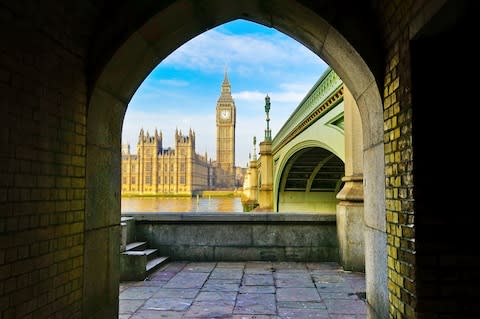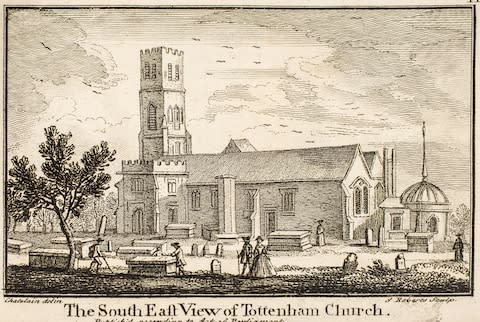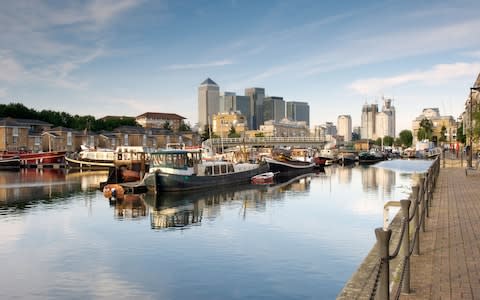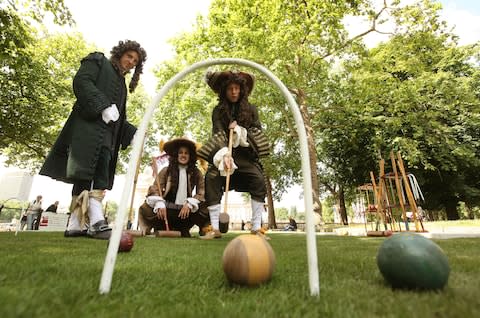The surprising origins of London's most curious place names

When you start thinking about London place names, you realise that they pose endless questions. Was Cheapside once cheap? Who were the knights in Knightsbridge? And where does a name like Piccadilly come from?
Names like this – indeed, any place names – are inextricably linked to history. They answer questions such as "why is it here?" or "who lived here?" London place names are more fun than most, because they cover a period of over 2,000 years and tell us all sorts of things about how our capital developed.
The early history of London is vague. We know that the Romans called it Londinium and that it was a busy trading centre in their time. But Londinium is a Latin version of an older Celtic name; attempts to explain its meaning have occupied scholars for centuries. Current best guess is "settlement at the unfordable part of the river", which would certainly be geographically accurate: the lowest fordable point on the Thames was about two miles upstream from Londinium.
Also lost in the mists of time is the meaning of Thames, which may mean something as simple as "flowing". A fairly basic name for a river, you might think, but then it would have been the only major one that the early inhabitants of London knew. Modern-day Londoners still refer to it as "the river", as if it were the only one that existed or at least the only one that mattered, and this may well have been the rationale for the Celts of 2,000 and more years ago.

The Romans left London surprisingly few place names, but they did leave the wall that guarded the settlement – you can see a chunk of it in the Museum of London, on the street called (reasonably enough) London Wall. To get in and out of the walled city it was necessary to pass through gates, substantial affairs offering accommodation to the gatekeepers and, in some cases, serving as prisons or as places to display the heads of executed traitors.
The gates were dismantled, along with the wall, in the 18th century, a time when London was expanding so much that they were just in the way. But the names linger on. Ludgate, commemorated in Ludgate Hill (where there is a plaque to mark its site) and Ludgate Circus, almost certainly means nothing more imaginative than "back gate" or "side gate".
Cripplegate originated not with cripples but with creeping: it may have been a low, covered passageway. And Aldgate may be a corruption of "ale gate", because ale was brewed nearby and sold to travellers entering the City.
After the Romans left, Britain was invaded by Angles and Saxons from northern Europe and it is to them that we owe the vast majority of the names of other, smaller settlements that were later subsumed into London.
Most places ending in –ham, –ton or –ington are named after otherwise forgotten Anglo-Saxon chiefs. Paddington, Kensington and Tottenham are three of these – originally farms or homesteads associated with Padda, Cynesige and Totta, whoever they were.
Similarly, a name ending in –ley is likely to have been a clearing in a wood and Wembley was the clearing associated with Wemba.

The Thames was the lifeline of London’s trade, so landing places on it were crucial. The Old English word for a landing place was hythe, still recognisable in Rotherhithe and Greenhithe, but also corrupted into Lambeth (where lambs were landed) and, less obviously, Chelsea (where chalk was landed) and Putney (once Puttenhuthe, possibly where hawks were landed, but more probably named after a man who had hawk-like features).
As well as all these outlying hamlets, the Anglo-Saxons sowed the seeds for London becoming the sprawling city it is today: they built a monastery or minster church to the west of the city. Expanded by their pious king Edward the Confessor, it became known as "the minster in the west" – Westminster.
After the Norman invasion of 1066, most of London’s business was still conducted in what we now call the City. To this day names tell us what was sold in the various streets: Cornhill was the site of the great corn market; Cheapside (from the Old English for market, which also survives in names such as Chipping Norton and Chipping Camden) was the main street, with Bread Street, Poultry and Ironmonger Lane nearby.
Stew Lane was equally explicit to a speaker of medieval English, who would have recognised that it advertised not casseroles but brothels.

Expansion over the centuries meant more and more development to the west. In the park adjacent to St James’s Palace, James I kept exotic birds: the road that ran alongside it is still called Birdcage Walk. Piccadilly was also named around this time: the word comes from the piccadill, a wide, decorated collar that was sufficiently popular to make the fortune of a tailor called Robert Baker.
When he built himself an impressive residence hereabouts it was promptly dubbed Piccadilly House, presumably by people who thought he was getting above himself.
After the Restoration of Charles II in 1660, the king gave great parcels of land in Mayfair (named after the spring fair once held here) to his supporters. Albemarle Street, Jermyn Street, Berkeley Square and the Burlington Arcade all commemorate Restoration courtiers.
So too does Arlington Street, named after the Earl of Arlington, who had the unenviable task of procuring and managing the royal mistresses – a pretty full-time job under Charles II, one would imagine.
Royalty, too, has left its mark on street names: all those Charles Streets, George Streets, Victoria Streets, Kingsway and Queensgate bear witness to the fact that royal patrons liked to have their patronage acknowledged.
Place names also commemorate public events: Trafalgar Square, Waterloo and, less famously, Maida Vale recall British victories in the Napoleon Wars.
Maida Vale in fact takes its name from a now vanished pub, the Hero of Maida; the hero in question was General Sir John Stuart, whose triumph at Maida in Italy did much to restore British morale after the defeat at Austerlitz. (The French are proud of that one and, like us with Waterloo, still have a station in Paris named after it.)
And finally, to answer the one remaining question from my first paragraph: there was indeed a bridge in Knightsbridge: it stood where the main road west went over a river called the West Bourne. "Knight", in earlier times, meant simply "lad", particularly one employed as a retainer.
One explanation for the name Knightsbridge is that it was a place where the local yoof hung out, long before those elegant department stores were thought of.
Caroline Taggart is the author of The Book of London Place Names.
More curious London place names – and what they mean
Bleeding Heart Yard
Legend has it that the body of Lady Elizabeth Hatton, brutally murdered in 1626, was found in Farringdon—her heart, torn from her body, was still beating nearby. Sceptics who frown on this urban legend claim the street was actually named after an old pub located there.
Cockpit Steps
In Westminster, a walkway named Cockpit Steps, running south of Birdcage Walk, marks the former site of royal cockfights. For much of London's history, cockfighting (and betting on cockfighting) was a popular pastime among the upper classes. The old Royal Cockpit was built in the 1700s. While this structure no longer exists, the steps remain, reminding travelers—for better or worse—of the old sport.
Fetter Lane
Fetter Lane (running north of Fleet Street) was apparently a place where medieval vagabonds congregated to feign diseases and other afflictions to evoke the pity of (and open the pocketbooks of) passersby. The name may be derived from the Middle English word faitour, which by medieval times had come to mean "false beggars."
Flask Walk
This Hampstead lane was the location of several taverns that sold flasks of water—from a medicinal spring nearby—to London's eating houses and others in the rapidly expanding 17th- and 18th-century city.

Houndsditch
Houndsditch, at the east end of London, was the medieval final resting place for the city's deceased dogs and the rubbish disposed with them. Ironically, Jeremy Bentham—philosopher, legal and social reformer, and champion of animal rights—was born on the street in 1748.
Mount Pleasant
Mount Pleasant was the tongue-in-cheek name for the medieval dumping ground of household refuse, ashes, and other trash, along the banks of the woefully polluted Fleet River in Clerkenwell (before the river was buried underground). The street name remains, though the irony is lost.
Old Jewry
Old Jewry, a one-way street near the present-day Guildhall, was once a Jewish settlement. Soon after the Norman Conquest, William the Conqueror encouraged Jews to come to England, and many ended up settling on or around Old Jewry in the city's Jewish quarter.
Pall Mall
Pall Mall's name is derived from the popular game of the same name that was imported from France and Italy in the 16th and 17th centuries. The game, in which a mallet was used to hit a ball through a hoop hanging aboveground, was commonly played there. Today Pall Mall serves as the address of choice for London's most celebrated and exclusive gentlemen's clubs.
Pudding Lane
Belying its charming sounding name, "pudding" was actually the medieval term for animal guts, and Pudding Lane was a riverside street that housed many a butcher shop. Animal innards were tossed out the overhanging windows; gravity, time, and the occasional broom would funnel the "pudding" down the sharply pitched street to the flowing waste removal system known as the Thames. But Pudding Lane is most notorious as the site where the Great Fire of London started in 1666.
Rotten Row
The story goes that Rotten Row, the mile-long (1.6 km) bridle path running along the southern edge of Hyde Park, derives its name from "Route du Roi," French for the King's Road, as this was the path William III built to travel to and from Kensington Palace. Debate prevails on the truth of this oft-repeated explanation... but let's just go with it.
Sherborne Lane
Running south of King William Street in the City, Sherborne Lane was formerly known as Shiteburne Lane - the street was a longtime public privy. London needed quite a few Sherborne Lanes; the human and animal inhabitants of medieval London produced 50 tons (45 tonnes) of excrement a day.
So those are our offerings for curious place names in Britain's capital city. But are there any we've missed? How about place names outside of London with an interesting history? From Upton Snodsbury in Worcestershire to Puddletown in Dorset, tell us about your favourite place names and their provenance in the comment section below.